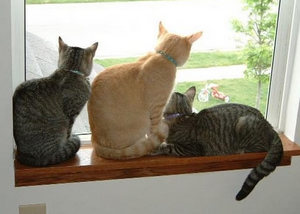Everyone teases about how loyal dogs are, as opposed to cats, who tend to act as if they own their humans. In some cases that’s true, but there are plenty of loyal and sweet-natured cats too. One on one with their owners, they may be the gentlest creature alive, yet put another cat in their home territory, and sometimes the fur flies. Cat fights are horrible to see, and even worse to hear! The noises that can come out of a cats mouth can sound like something between the scream of a mountain lion, and the roar of a lion, mixed with a lot of spitting, sputtering and yowling. There are a few tips you can try if you have indoor cats that are fighting with each other.
While some cats get along very well with others, there may be a dominant streak in the eldest, the largest or sometimes even the smallest cat in the house. Unlike dogs, cats don’t usually seek as much attention from their owners. Not saying that they don’t love attention, and need it too, but they adjust somewhat better if they happen to be left alone for a few hours at a time.
Female cats will usually get along better with other females, as opposed to males that spend time together. Making sure that both sexes are spayed and/or neutered is a must to help stop cat fights inside the home. Even with the best natured cats, there is usually one leader and all others in the home are counted as lowly followers. This isn’t necessarily a bad thing, as long as the leader isn’t a bully. Most animal groups naturally have a dominant leader in their midst.
One way to control a cat fight is to make sure there is enough food out for all. You may even need to feed everyone out of a separate bowl, and put the bowls in different rooms. Sharing food can be a big problem for some cats, so avoiding the problem by separating them at mealtimes should help.
Don’t try to keep too many cats in the same house. By limiting the number of cats in the home, you will limit the opportunity of fighting to be the King or Queen of the group. Two cats are usually fine together if introduced at young ages, but place a third cat in the midst of the other two that are already settled in their territory, (your home), and problems can arise quickly.
If you are bringing home a new cat, especially an adult cat, never simply set it down for the others to meet. Introducing a new cat to the others takes time. It is usually a good idea to keep the new cat in its crate for a while when you first bring it home, then gradually let it out while you are standing nearby. Talk to your other cats in a soothing tone. This helps them know that you think the new kitty being there is okay, and might trick them into thinking the same thing! The established cats may turn their backs on the new addition for a few days, but eventually they should be fine.
Sources:
http://www.petsnanny.net/why-cats-fight.htm
http://www.cats.about.com/cs/behavioralissues/a/aggression_cats
http://www.blurtit.com/q2605115.html




